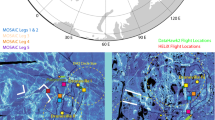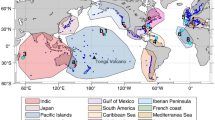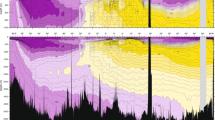Abstract
IN the summer of 1875, I made a tour of inspection to our meteorological stations in the surveying-steamer Hansteen, Capt. M. Petersen, R.N. During the morning hours of August 7, I was on shore at Gandfjord, on the south side of the Varangerfjord, and measured the height of some terraces there. At 1h. 10m. p.m. we took serial temperatures in the Gandfjord with the deep-sea thermometer. The weather was calm, and a dense fog prevailed. The temperature of the air was 12° C. Leaving the Gandfjord we proceeded northwards. The dense fog continued. At once the fog began to be lighter and the sun to shine through, and a few minutes afterwards we were out of the fog, which was standing as a white wall in the south-west. In the moment the sun appeared, but before we were quite clear of the fog, I saw in the north-east a bow having the shape of a rainbow, but quite white, projected on the fog. With a sextant I measured its amplitude, or the chord along the horizon, and the height of the summit above the horizon—in both cases the middle between the outer and inner edge of the bow. The horizon not being distinctly visible, it is probable that the measures taken do not exactly refer to the true horizon, nor is it certain that the height of the summit was taken from the same horizontal plane in which the amplitude was measured. By the captain's reckoning, the apparent ship's time, at the moment of observation, was 2h. 40m., and the latitude 70° 1′. From these data, and the declination of the sun, I computed the azimuth of the sun at south 46° 5′ west, and its apparent altitude at 31° 12′. Supposing, as the results of the several computations tend to indicate, that the white bow is circular, and has its centre in the anthelic point, we may calculate the angular radius of the bow by three different methods.
This is a preview of subscription content, access via your institution
Access options
Subscribe to this journal
Receive 51 print issues and online access
$199.00 per year
only $3.90 per issue
Buy this article
- Purchase on Springer Link
- Instant access to full article PDF
Prices may be subject to local taxes which are calculated during checkout
Similar content being viewed by others
Author information
Authors and Affiliations
Rights and permissions
About this article
Cite this article
MOHN, H. The Fog Bow and Ulloa's Ring. Nature 37, 391–392 (1888). https://doi.org/10.1038/037391a0
Published:
Issue Date:
DOI: https://doi.org/10.1038/037391a0
Comments
By submitting a comment you agree to abide by our Terms and Community Guidelines. If you find something abusive or that does not comply with our terms or guidelines please flag it as inappropriate.



